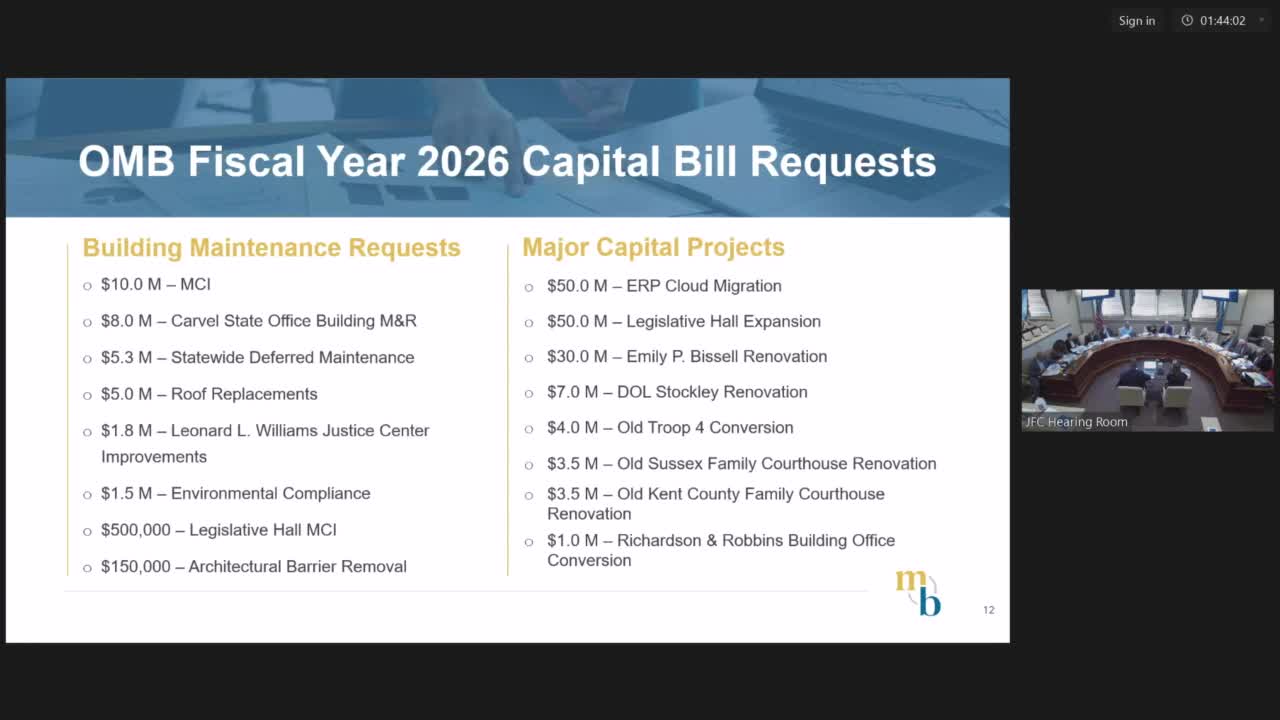Housing authority seeks $25 million-plus package to expand production, downtown reinvestment and rental assistance
March 31, 2025 | 2025 Legislature DE Collection, Delaware
This article was created by AI summarizing key points discussed. AI makes mistakes, so for full details and context, please refer to the video of the full meeting. Please report any errors so we can fix them. Report an error »

The Delaware State Housing Authority presented a multi-pronged housing and homelessness package to the committee focused on increasing affordable housing supply, downtown reinvestment and rental assistance.
DSHA Director Matthew Heckles said the governor's recommended capital package would include $15 million for the Housing Development Fund (HDF), $5.5 million for the Downtown Development District (DDD) program, $3 million for a newly launched workforce housing program, and $2 million for the Strong Neighborhoods housing fund. Director Heckles told the committee the HDF is flexible and is the primary vehicle to subsidize low‑income rental housing and support projects that leverage federal Low‑Income Housing Tax Credit equity. He described how HDF allocations in prior years helped leverage tax credit equity and other grant and private financing in projects such as Riverside/Imani Village in Wilmington and smaller rehabilitation projects.
Heckles said housing supply remains constrained, noting the state now has a unified public housing waiting list with more than 32,000 applicants since the list was opened; he said roughly 50,000 Delaware renter households spend more than 30 percent of their income on housing. The director asked for continued operating support as well: the governor's operating recommendations include $10 million for DSHA programs, including a $2 million increase for the State Rental Assistance Program (SRAP). DSHA said the SRAP increase would expand the number of households served and help the program keep pace with rising rents.
Heckles also described the Downtown Development Districts program as a high‑leverage economic development tool; DSHA noted $40 million invested since inception yielded more than $575 million in private investment in downtown projects. The Strong Neighborhoods fund will continue to acquire, renovate and return vacant or distressed properties to productive use.
Ending: Heckles asked the committee to support the recommended capital and operating funds, saying they are intended both to accelerate production of new affordable housing and to preserve existing stock while providing targeted rental assistance for households at risk of homelessness.
DSHA Director Matthew Heckles said the governor's recommended capital package would include $15 million for the Housing Development Fund (HDF), $5.5 million for the Downtown Development District (DDD) program, $3 million for a newly launched workforce housing program, and $2 million for the Strong Neighborhoods housing fund. Director Heckles told the committee the HDF is flexible and is the primary vehicle to subsidize low‑income rental housing and support projects that leverage federal Low‑Income Housing Tax Credit equity. He described how HDF allocations in prior years helped leverage tax credit equity and other grant and private financing in projects such as Riverside/Imani Village in Wilmington and smaller rehabilitation projects.
Heckles said housing supply remains constrained, noting the state now has a unified public housing waiting list with more than 32,000 applicants since the list was opened; he said roughly 50,000 Delaware renter households spend more than 30 percent of their income on housing. The director asked for continued operating support as well: the governor's operating recommendations include $10 million for DSHA programs, including a $2 million increase for the State Rental Assistance Program (SRAP). DSHA said the SRAP increase would expand the number of households served and help the program keep pace with rising rents.
Heckles also described the Downtown Development Districts program as a high‑leverage economic development tool; DSHA noted $40 million invested since inception yielded more than $575 million in private investment in downtown projects. The Strong Neighborhoods fund will continue to acquire, renovate and return vacant or distressed properties to productive use.
Ending: Heckles asked the committee to support the recommended capital and operating funds, saying they are intended both to accelerate production of new affordable housing and to preserve existing stock while providing targeted rental assistance for households at risk of homelessness.
View full meeting
This article is based on a recent meeting—watch the full video and explore the complete transcript for deeper insights into the discussion.
View full meeting
